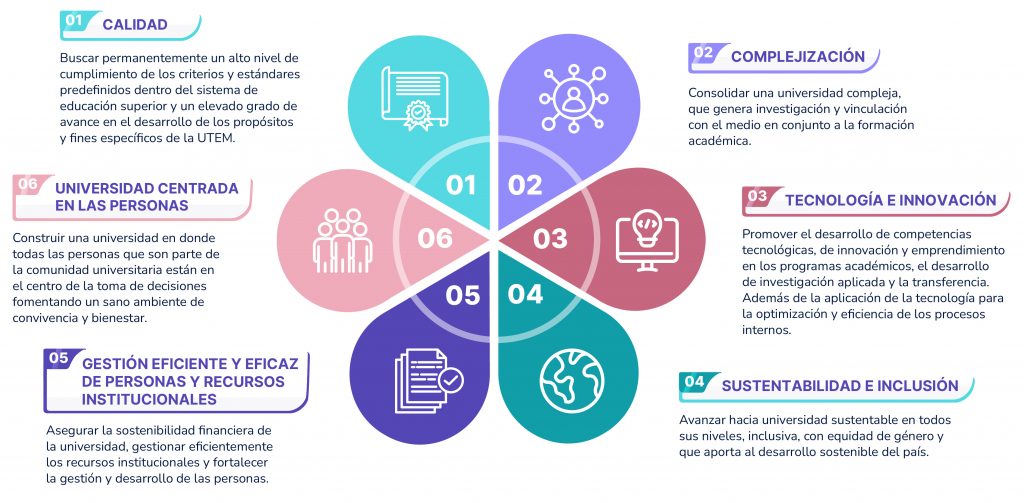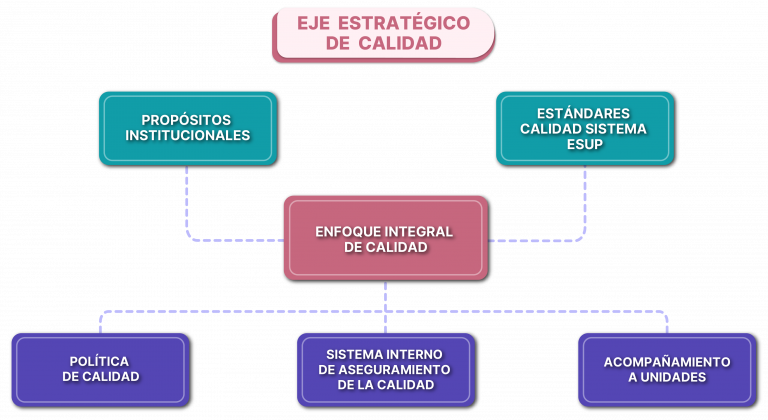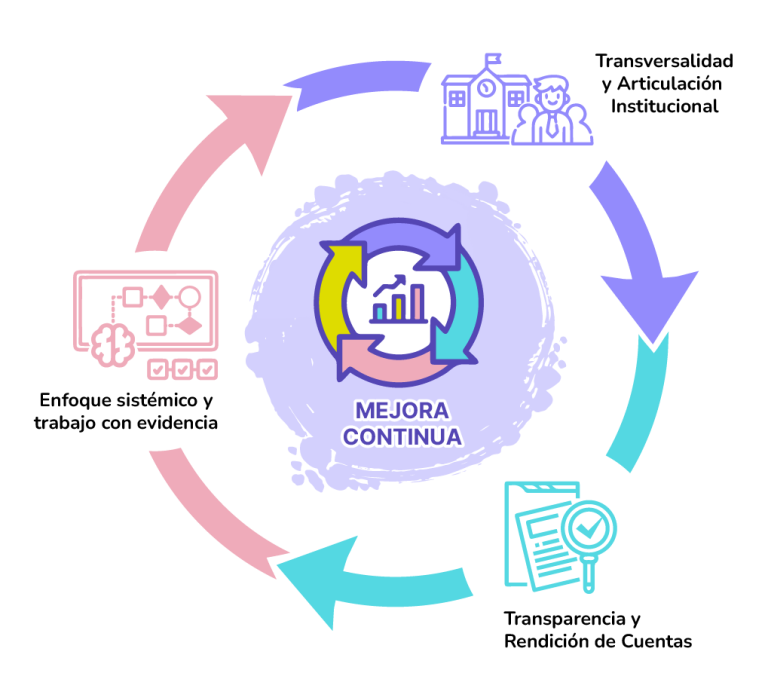La Universidad Tecnológica Metropolitana, sobre la base de su compromiso público, se ha propuesto enfrentar los nuevos desafíos de la sociedad con una estrategia integral que busca posicionarla como una universidad estatal de excelencia en el campo de la sustentabilidad, la responsabilidad social, la innovación y el desarrollo de las ciencias y la tecnología.
Con la modernización y la complejización de su quehacer como lineamientos generales, la UTEM definió en 2021 la Calidad como el primero de sus seis ejes estratégicos, los que orientarán su gestión hasta 2030.

Alcanzar un alto nivel de cumplimiento de los criterios y estándares establecidos en el sistema de educación superior.
Lograr un avance sostenido en el desarrollo de los propósitos y fines institucionales.
Ambas orientaciones conducen a la institución a concebir un enfoque integral de la calidad, el que contempla:
UNA POLÍTICA
TRANSVERSAL
UN SISTEMA ARTICULADO
E INTEGRADO DE ASEGURAMIENTO
DE LA CALIDAD
EL FORTALECIMIENTO Y ACOMPAÑAMIENTO DE LAS UNIDADES PARA GARANTIZAR LA MEJORA CONTINUA

A partir del Plan de Fortalecimiento de Universidades Estatales, del cual la UTEM forma parte, la institución desarrolla una serie de proyectos que materializan los objetivos estratégicos definidos para la década 2020–2030. Así se comprometen metas comunes entre las universidades del Estado, posibles de alcanzar gracias al trabajo colaborativo y mancomunado que las caracteriza.
El Sistema Nacional de Aseguramiento de la Calidad ha sido fundamental para garantizar que las instituciones de educación superior en Chile entreguen un servicio de calidad. En la UTEM, asumimos este desafío como parte del compromiso público de fortalecer las universidades estatales, integrando un enfoque de calidad integral y transversal en todas nuestras áreas y procesos.
Nuestra Política Integral de Calidad y el Sistema Institucional de Aseguramiento de la Calidad (SINAC) son el eje de este compromiso. Basándonos en evidencia confiable y un monitoreo constante mediante indicadores claros, implementamos mecanismos que nos permiten diseñar, evaluar y ajustar nuestros procesos bajo los principios de mejora continua y rendición de cuentas.
Este enfoque no solo fortalece la autoevaluación y acreditación, sino que fomenta una cultura de calidad arraigada en la UTEM. Más que un requisito, la calidad es un valor esencial que guía cada decisión, asegurando que nuestra institución esté a la altura de las expectativas de la sociedad y comprometida con la excelencia en cada ámbito.
Aprobada en diciembre de 2022, la Política Integral de Gestión y Aseguramiento de la Calidad UTEM define la calidad como un eje central para el logro de los propósitos institucionales y estándares externos. Su enfoque se fundamenta en los siguientes principios que guían cada proceso y aseguran una gestión alineada con la excelencia.

Esta política busca sentar los lineamientos bajo los cuales se despliega en la universidad
la gestión y el aseguramiento de la calidad, sobre la base de dos pilares fundamentales:
Esta política busca sentar los lineamientos bajo los cuales se despliega en la universidad la gestión y el aseguramiento de la calidad, sobre la base de dos pilares fundamentales:
La política institucional establece el marco que orienta el aseguramiento de la calidad
y la gestión estratégica en la Universidad, articulando sus lineamientos con dos sistemas clave:
La política institucional establece el marco que orienta el aseguramiento de la calidad
y la gestión estratégica en la Universidad, articulando sus lineamientos con dos sistemas clave:
El Sistema Estratégico de Gestión Institucional (SGES), que organiza y mejora los procesos en todas las áreas.
El Sistema Institucional de Aseguramiento de Calidad (SINAC), que garantiza la calidad mediante estándares y evaluaciones continuas.
El Sistema Estratégico de Gestión Institucional (SGES), que organiza y mejora los procesos en todas las áreas.
El Sistema Institucional de Aseguramiento de Calidad (SINAC), que garantiza la calidad mediante estándares y evaluaciones continuas.
Ambos sistemas, en conjunto, traducen la política en acciones concretas para cumplir los objetivos estratégicos institucionales.
Haz clic aquí para descargar la Política Integral de Gestión y Aseguramiento de la Calidad UTEM
Calidad UTEM
We firmly believe that the internet should be available and accessible to anyone, and are committed to providing a website that is accessible to the widest possible audience, regardless of circumstance and ability.
To fulfill this, we aim to adhere as strictly as possible to the World Wide Web Consortium’s (W3C) Web Content Accessibility Guidelines 2.1 (WCAG 2.1) at the AA level. These guidelines explain how to make web content accessible to people with a wide array of disabilities. Complying with those guidelines helps us ensure that the website is accessible to all people: blind people, people with motor impairments, visual impairment, cognitive disabilities, and more.
This website utilizes various technologies that are meant to make it as accessible as possible at all times. We utilize an accessibility interface that allows persons with specific disabilities to adjust the website’s UI (user interface) and design it to their personal needs.
Additionally, the website utilizes an AI-based application that runs in the background and optimizes its accessibility level constantly. This application remediates the website’s HTML, adapts Its functionality and behavior for screen-readers used by the blind users, and for keyboard functions used by individuals with motor impairments.
If you’ve found a malfunction or have ideas for improvement, we’ll be happy to hear from you. You can reach out to the website’s operators by using the following email
Our website implements the ARIA attributes (Accessible Rich Internet Applications) technique, alongside various different behavioral changes, to ensure blind users visiting with screen-readers are able to read, comprehend, and enjoy the website’s functions. As soon as a user with a screen-reader enters your site, they immediately receive a prompt to enter the Screen-Reader Profile so they can browse and operate your site effectively. Here’s how our website covers some of the most important screen-reader requirements, alongside console screenshots of code examples:
Screen-reader optimization: we run a background process that learns the website’s components from top to bottom, to ensure ongoing compliance even when updating the website. In this process, we provide screen-readers with meaningful data using the ARIA set of attributes. For example, we provide accurate form labels; descriptions for actionable icons (social media icons, search icons, cart icons, etc.); validation guidance for form inputs; element roles such as buttons, menus, modal dialogues (popups), and others. Additionally, the background process scans all of the website’s images and provides an accurate and meaningful image-object-recognition-based description as an ALT (alternate text) tag for images that are not described. It will also extract texts that are embedded within the image, using an OCR (optical character recognition) technology. To turn on screen-reader adjustments at any time, users need only to press the Alt+1 keyboard combination. Screen-reader users also get automatic announcements to turn the Screen-reader mode on as soon as they enter the website.
These adjustments are compatible with all popular screen readers, including JAWS and NVDA.
Keyboard navigation optimization: The background process also adjusts the website’s HTML, and adds various behaviors using JavaScript code to make the website operable by the keyboard. This includes the ability to navigate the website using the Tab and Shift+Tab keys, operate dropdowns with the arrow keys, close them with Esc, trigger buttons and links using the Enter key, navigate between radio and checkbox elements using the arrow keys, and fill them in with the Spacebar or Enter key.Additionally, keyboard users will find quick-navigation and content-skip menus, available at any time by clicking Alt+1, or as the first elements of the site while navigating with the keyboard. The background process also handles triggered popups by moving the keyboard focus towards them as soon as they appear, and not allow the focus drift outside of it.
Users can also use shortcuts such as “M” (menus), “H” (headings), “F” (forms), “B” (buttons), and “G” (graphics) to jump to specific elements.
We aim to support the widest array of browsers and assistive technologies as possible, so our users can choose the best fitting tools for them, with as few limitations as possible. Therefore, we have worked very hard to be able to support all major systems that comprise over 95% of the user market share including Google Chrome, Mozilla Firefox, Apple Safari, Opera and Microsoft Edge, JAWS and NVDA (screen readers), both for Windows and for MAC users.
Despite our very best efforts to allow anybody to adjust the website to their needs, there may still be pages or sections that are not fully accessible, are in the process of becoming accessible, or are lacking an adequate technological solution to make them accessible. Still, we are continually improving our accessibility, adding, updating and improving its options and features, and developing and adopting new technologies. All this is meant to reach the optimal level of accessibility, following technological advancements. For any assistance, please reach out to